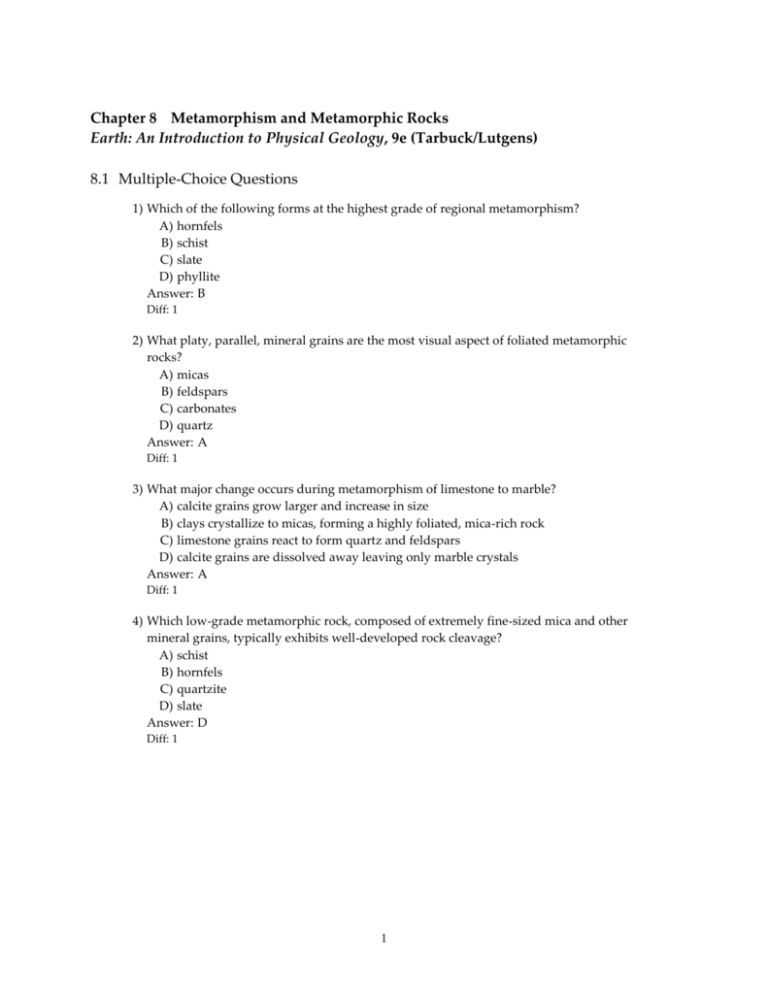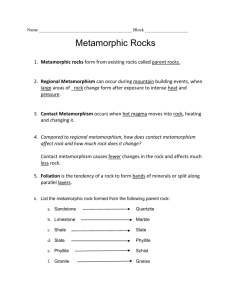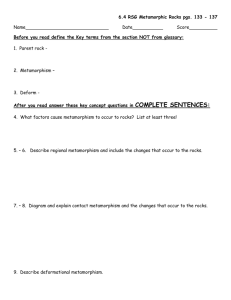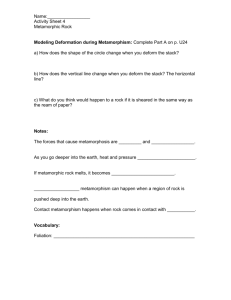Earth,Notes,RevQs,Ch8
advertisement

Chapter 8 Metamorphism and Metamorphic Rocks Earth: An Introduction to Physical Geology, 9e (Tarbuck/Lutgens) 8.1 Multiple-Choice Questions 1) Which of the following forms at the highest grade of regional metamorphism? A) hornfels B) schist C) slate D) phyllite Answer: B Diff: 1 2) What platy, parallel, mineral grains are the most visual aspect of foliated metamorphic rocks? A) micas B) feldspars C) carbonates D) quartz Answer: A Diff: 1 3) What major change occurs during metamorphism of limestone to marble? A) calcite grains grow larger and increase in size B) clays crystallize to micas, forming a highly foliated, mica-rich rock C) limestone grains react to form quartz and feldspars D) calcite grains are dissolved away leaving only marble crystals Answer: A Diff: 1 4) Which low-grade metamorphic rock, composed of extremely fine-sized mica and other mineral grains, typically exhibits well-developed rock cleavage? A) schist B) hornfels C) quartzite D) slate Answer: D Diff: 1 1 Match the rock with the appropriate description. A. hornfels B. marble C. gneiss D. phyllite 5) ________ forms by contact metamorphism of mudstones and shales Answer: A Diff: 1 6) ________ foliated, fine-grained metamorphic rock formed from mudstone and shale Answer: D Diff: 1 7) ________ nonfoliated metamorphic rock consisting mostly of calcite Answer: B Diff: 1 8) ________ coarse-grained, metamorphic rock with alternating bands or stringers of light and dark minerals Answer: C Diff: 1 9) ________ is thought to form by partial melting and in situ crystallization of the melted portion. A) Magmatite B) Magnetite C) Migmatite D) Megatite Answer: C Diff: 1 10) Tektites originate in what metamorphic environment? A) low pressure and high temperature associated with volcanism B) high temperatures associated with meteorite impacts C) very high pressures and temperatures associated with deep subduction D) high temperatures and shearing stresses in an oceanic-crust transform fault Answer: B Diff: 1 11) Which one of the following is not likely to be genetically associated with impact of an asteroid or large meteorite? A) tektites B) blueschists C) coesite D) impact crater Answer: B Diff: 1 2 12) Which of the following statements concerning slate is not true? A) forms from shales and mudstones B) has abundant, coarse-grained mica C) rock cleavage is common D) sedimentary features may be visible Answer: B Diff: 1 13) ________ is a strong, parallel alignment of coarse mica flakes and/or of different mineral bands in a metamorphic rock. A) Rock cleavage B) Foliation C) Stress streaking D) Marbleizing Answer: B Diff: 1 14) ________ is a nonfoliated rock formed by contact metamorphism of a shale or mudstone. A) Schist B) Marble C) Gneiss D) Hornfels Answer: D Diff: 1 15) Which of the following would exhibit sheared and mechanically fragmented rocks? A) fault movements at shallow depths B) intense compression in a deep-seated, regional metamorphic zone C) heating of shales and mudstones near a pluton D) regional metamorphism of pyroclastic volcanic rocks Answer: A Diff: 1 16) Which of the following best describes the conditions of contact metamorphism? A) Pressures are very high, the rock is deeply buried, and temperatures are raised by the Earth's internal heat. B) Pressures are fairly low, the rock is in the upper part of the crust, and heat is supplied from a nearby magma body. C) Heat is generated by shearing and mechanical movements along faults. D) Depths are fairly shallow, but temperatures and pressures are so high that the rocks begin to partially melt. Answer: B Diff: 1 3 17) ________ forms from the metamorphism of limestone or dolostone. A) Migmatite B) Amphibolite C) Marble D) Quartzite Answer: C Diff: 1 18) What foliated, metamorphic rock is texturally intermediate between slate and schist? A) fault breccia B) phyllite C) quartzite D) gneiss Answer: B Diff: 1 19) ________ is characterized by the segregation of light- and dark-colored minerals into thin layers or bands. A) Garnet hornfels B) Granitic gneiss C) Slate D) Quartzite Answer: B Diff: 1 20) What type of foliation results from the parallel alignment of abundant, coarse-grained, mica flakes in a metamorphic rock? A) schistosity B) gneissic banding C) slaty cleavage D) phyllitic structure Answer: A Diff: 1 21) Which of the following metamorphic rocks could be used to neutralize acidic mine waters? A) granite gneiss B) quartzite C) slate D) marble Answer: D Diff: 1 4 22) Which of the following lists the rocks in the order of increasing grain size and increasing grade of metamorphism? A) phyllite, slate, schist B) schist, slate, phyllite C) slate, phyllite, schist D) slate, schist, phyllite Answer: C Diff: 1 23) ________ is typically formed by metamorphism of a sandstone. A) Marble B) Slate C) Amphibolite D) Quartzite Answer: D Diff: 1 24) Which of the following rocks would exhibit visible, textural evidence of having undergone some partial melting? A) fault breccia B) migmatite C) slate D) foliated hornfels Answer: B Diff: 1 25) What is the major source of heat for contact metamorphism? A) deep burial and heat from the Earth's interior B) heat from grinding and shearing on faults C) heat from the spontaneous decomposition of micas and feldspars D) heat from a nearby magma body Answer: D Diff: 1 26) In which setting would regional metamorphism be most likely? A) at shallow depths below an oceanic ridge or rift zone B) at shallow depths along major transform faults in the continental crust C) at great depths in the crust where two continents are colliding D) at shallow depths beneath the seafloor where water pressures are immense Answer: C Diff: 2 5 27) Graphite is identified in a particular schist. Which one of the following conclusions is justified? A) The rock also contains diamonds; both are crystalline forms of the element carbon. B) The schist formed from a quartz-rich, sedimentary limestone. C) The graphite lubricated shearing movements along a fault, causing a schist to form. D) The pre-metamorphic rock was a shale or mudstone containing organic matter. Answer: D Diff: 2 28) Amphibolite is a foliated metamorphic rock composed principally of hornblende and plagioclase. How does it form? A) by contact metamorphism of sandstone along the contact with a granitic batholith B) by regional metamorphism of volcanic rocks such as andesite and basalt C) by gouging and crushing of limestone along a fault D) by the impact of an asteroid on interbedded sandstone and shale Answer: B Diff: 1 29) What term describes the zone of contact metamorphism surrounding an intrusive magma body? A) aura B) auricle C) oracle D) aureole Answer: D Diff: 1 30) During metamorphism, what is the major effect of chemically active fluids? A) increase the pressures in deeply buried, regional-metamorphic zones B) aid in the movement of dissolved silicate constituents and facilitate growth of the mineral grains C) prevent partial melting so solid rocks can undergo very high temperature regional metamorphism D) facilitate the formation of schistosity and gneissic banding in hornfels and slates Answer: B Diff: 1 31) What two, metamorphic rocks are composed predominantly of single minerals? A) mica schist and granitic gneiss B) fault breccia and graphitic schist C) garnet schist and hornfels D) marble and quartzite Answer: D Diff: 1 6 32) A ________ forms at very high pressures but moderately low temperatures associated with subduction of oceanic crust and sediments. A) mylonite B) migmatite C) biotite marble D) blueschist Answer: D Diff: 1 8.2 Word Analysis Questions Examine the words and/or phrases for each question below and determine the relationship among the majority of words/phrases. Choose the option which does not fit the pattern. 1) A) pressure B) recrystallization C) melting D) chemical fluids Answer: melting Diff: 1 2) A) porphyroblastic B) slaty cleavage Answer: porphyroblastic C) schistosity D) gneissic texture B) hornfels C) skarn D) schist B) quartzite C) slate D) schist Diff: 1 3) A) aureole Answer: schist Diff: 2 4) A) phyllite Answer: quartzite Diff: 1 8.3 True/False Questions 1) Partial melting is an important process in the formation of migmatites. Answer: TRUE Diff: 1 2) Slate and schist are both derived by metamorphism of shales and mudstones. Answer: TRUE Diff: 1 3) Hornfels are metamorphic rocks produced at great depths and high temperatures associated with regional metamorphism. Answer: FALSE Diff: 1 4) Calcite is the main mineral constituent of the sedimentary rock limestone and of the metamorphic rock marble. Answer: TRUE Diff: 1 7 5) Metamorphic rocks formed during episodes of mountain building typically show textural characteristics indicative of shearing stress and deformation. Answer: TRUE Diff: 1 6) Amphibolites have gneissic textures and form by regional metamorphism of granites and rhyolites. Answer: FALSE Diff: 1 7) At high pressures and elevated temperatures of regional metamorphism, silicate rocks are more resistant to flowage and deformation than at low temperatures and pressures. Answer: FALSE Diff: 1 8) Foliated metamorphic rocks are composed largely of equidimensional grains of minerals such as quartz and calcite. Answer: FALSE Diff: 1 9) Rock cleavage or slaty cleavage in slates is largely a consequence of abundant, parallelaligned, very fine-grained mica flakes in the rock. Answer: TRUE Diff: 1 10) Muscovite, biotite, and chlorite are common minerals found in phyllites and schists. Answer: TRUE Diff: 1 11) The distinctive layers or bands of different minerals in gneisses may be complexly folded. Answer: TRUE Diff: 1 12) Quartzites and metaconglomerates are formed along faults by intensive fracturing and fragmentation of conglomerate beds and quartz veins. Answer: FALSE Diff: 1 13) High-grade, regional metamorphism produces significant and recognizable changes in the textures and mineral compositions of rocks. Answer: TRUE Diff: 1 14) Talc and graphite are very soft minerals found in some schists. Answer: TRUE Diff: 1 8 15) Three major factors involved in metamorphism are elevated temperature, elevated pressure, and the chemical action of hot fluids. Answer: TRUE Diff: 1 16) During metamorphism, most rock is composed of solid mineral grains, but small amounts of hot fluids or partial melting may facilitate the metamorphic process. Answer: TRUE Diff: 1 8.4 Short Answer Questions 1) Give the name of a rock formed by regional metamorphism of a conglomerate. Answer: metaconglomerate Diff: 1 2) Which type of metamorphism occurs specifically in the heated zone around a pluton or other body of magma? Answer: contact Diff: 1 3) List the three most important agents of metamorphism. Answer: heat, pressure, chemically active fluids Diff: 1 4) What type of sedimentary rock is typically metamorphosed to form slates or phyllites? Answer: shale or mudstone Diff: 1 5) Foliation in metamorphic rocks is mainly evident in the parallel alignment of certain mineral grains. What are they? Answer: micas Diff: 1 6) Which metamorphic rock or rocks exhibit alternating layers or bands of different light- and dark-colored minerals? Answer: gneiss Diff: 1 7) Which metamorphic rock, widely used for monuments and buildings, would deteriorate significantly in contact with acid rain? Answer: marble Diff: 1 8) What strongly banded, metamorphic rocks show good evidence for having formed by partial melting? Answer: migmatite Diff: 1 9 9) What metamorphic rock forms by intense ductile deformation along fault zones at depth in the Earth? Answer: mylonite Diff: 1 8.5 Critical Thinking Questions Use complete sentences, correct spelling, and the information presented in Chapter 8 to answer the questions below 1) Is it always possible to determine the original parent rock (called a protolith) prior to metamorphism? Why or why not? List three protoliths and give a possible metamorphic equivalent for each one. Diff: 3 2) Briefly outline how regional metamorphism is related to plate boundaries. Are certain types of metamorphic rocks indicative of particular plate boundaries or tectonic settings? Give two or three examples of such rocks and indicate the tectonic environment they represent. Diff: 3 3) Is the texture of a metamorphic rock always indicative of the conditions (degree of metamorphism) under which it formed? (Hint: Think about the protolith and how it may influence the resulting metamorphic rock.) Diff: 2 8.6 Visualization Questions 1) What type of stress (pressure) is illustrated in the diagram below? Answer: confining pressure Diff: 1 2) What type of stress (pressure) is illustrated in the diagram below? 10 Answer: differential stress Diff: 1 3) Carefully examine the photograph below of a metamorphic rock sample. The sample is shown as its actual size. Is this rock foliated or nonfoliated? a) ________ What is the name of this metamorphic rock? b) ________ Consider how this rock got its texture. Was is compressed from top to bottom or from side to side? c) ________ Answer: a) foliated b) gneiss c) side to side Diff: 1 11 4) Carefully examine the cross section below of a subduction zone, and note the areas labeled A, B, or C. At which location (A, B, or C) would a metamorphic regime occur that is characterized by high temperature and high pressure? a) ________ At which location (A, B, or C) would a metamorphic regime occur that is characterized by high temperature and low pressure? b) ________ At which location (A, B, or C) would a metamorphic regime occur that is characterized by low temperature and high pressure? c) ________ At which location (A, B, and C) would blueschist form? d) ________ Answer: a) Box B b) Box C c) Box A d) Box A Diff: 2 12









